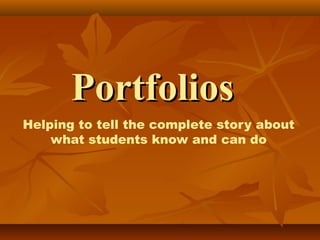
Portfolio Assessment Basics
- 1. PortfoliosPortfolios Helping to tell the complete story about what students know and can do
- 3. Multiple Measures of AssessmentMultiple Measures of Assessment District Assessments TPRI DRA Quizzes and Tests Teacher Observations Running Records Cumulative Collections of student work Project based assessments Beginning, Middle & End of Year Assessments Portfolios Assessments On-going Assessments Getting the complete picture of student performance
- 4. What is a portfolio?What is a portfolio? A purposefulpurposeful collection of work that demonstrates a student’s efforts, progress, and achievements over time Includes work samples and students’ reflections on the work Is notnot a random collection of work Contents are tied to major objectives and/or are student’s own selections
- 5. How a Portfolio is DevelopedHow a Portfolio is Developed Standard (TEKS) What student should know or be able to do Design a performance task that allows students to show what they know What does good performance look like? Set criteria Use a rubric (scoring guide) to assess student Performance.
- 6. For ExampleFor Example Construct concrete models of equivalent fractions Student draws a sketch to show why 3/6 is equal to 2/4. Student explains his thinking about the sketch in writing The student sketch must show that the shaded areas of 3/6 and 2/4 are the same size. Writing shows a clear understanding. Rubric helps teacher and student objectively evaluate work on a scale of one (novice) to four (distinguished) TEK Task Criteria Assessment
- 7. OrOr Use good descriptive detail when writing so that your reader understands what you are saying Students will take telling sentences and expand them into a showing paragraphs with rich, descriptive detail The writing will contain vivid, specific, descriptive language that paints a “mind picture” for the reader Rubric helps teacher and student objectively evaluate work on a scale of one (novice) to four (distinguished) TEK Task Criteria Assessment
- 8. A rubric is a scoring tool that lists the criteria for a piece of work, or “what counts” and clearly defines range of quality for each criterion, from excellent to poor.
- 9. Our Scoring ScaleOur Scoring Scale NoviceNovice (Beginner, skill is brand-new, needs almost total support)(Beginner, skill is brand-new, needs almost total support) ApprenticeApprentice (Learning, skills are developing, needs moderate support)(Learning, skills are developing, needs moderate support) ProficientProficient ((MasteryMastery ..Very capable, independent)Very capable, independent) DistinguishedDistinguished (Great skillfulness and knowledge, can teach and lead others,(Great skillfulness and knowledge, can teach and lead others, uniquely creative perspective)uniquely creative perspective)
- 11. A rubric is an authentic assessment tool which is particularly useful in assessing criteria which are complex and subjective.
- 12. Authentic assessment corresponds as closely as possible to real world experience. It was originally developed in the arts and apprenticeship systems, where assessment has always been based on performance.
- 13. •How will the work be assessed? •What’s the difference between novice work and proficient work? •How can we make sure our scores are valid?
- 14. Rubrics:Rubrics: •Make expectations clearMake expectations clear •Help students judge their own workHelp students judge their own work •Easy to use and explainEasy to use and explain •Make scoring fair and consistentMake scoring fair and consistent
- 15. Portfolio ContentsPortfolio Contents Includes work samples that show mastery ofIncludes work samples that show mastery of or progress toward mastery of the TEKSor progress toward mastery of the TEKS StudentsStudents’’ reflections on their own learningreflections on their own learning Could be:Could be: Photos and or videos ofPhotos and or videos of performances/projectsperformances/projects Teacher observationsTeacher observations Lists (such asLists (such as ““books readbooks read””)) Student-selectedStudent-selected ““best piecesbest pieces”” Drawings, journals, any work that is aDrawings, journals, any work that is a window into student thinking and learningwindow into student thinking and learning Drafts and finished piecesDrafts and finished pieces
- 16. Research supports that portfolios:Research supports that portfolios: Engage students in learning contentEngage students in learning content Help students learn the skills of reflectionHelp students learn the skills of reflection and self evaluationand self evaluation Document student learning in areas thatDocument student learning in areas that do not lend themselves to traditionaldo not lend themselves to traditional assessmentassessment Facilitate communication with parentsFacilitate communication with parents Three-way portfolio conferences led byThree-way portfolio conferences led by student to share portfolio with teacher,student to share portfolio with teacher, parents at end of yearparents at end of year
- 17. Ownership and Goal SettingOwnership and Goal Setting ““When I look at how much I have improved, it makesWhen I look at how much I have improved, it makes me feel good.me feel good.”” Jackie, grade 4Jackie, grade 4 ““When I evaluate a piece, I see what I have to do for theWhen I evaluate a piece, I see what I have to do for the next piece.next piece.”” Lauren, grade 5Lauren, grade 5 ““I will improve my spelling by putting words from myI will improve my spelling by putting words from my own writing on my spelling list.own writing on my spelling list.”” Aaron, grade 2Aaron, grade 2 From An Introduction to Using Portfolios in the Classroom by Danielson and Abrutyn
- 18. Portfolio ConferencesPortfolio Conferences First two weeks in OctoberFirst two weeks in October 45 minute slots45 minute slots January 29th – February 9thJanuary 29th – February 9th 30 minutes planned30 minutes planned End of Year Portfolio celebrationEnd of Year Portfolio celebration May 14-25thMay 14-25th Student ledStudent led
- 19. SummarySummary Adding portfolios to current assessments willAdding portfolios to current assessments will give a complete picture what students knowgive a complete picture what students know and can doand can do Parents will review portfolios at conferencesParents will review portfolios at conferences and see detailed feedback about strengths andand see detailed feedback about strengths and areas needing improvementareas needing improvement Students will learn to evaluate their own workStudents will learn to evaluate their own work and examine their thinkingand examine their thinking
- 20. We are excited about portfolios!We are excited about portfolios!
